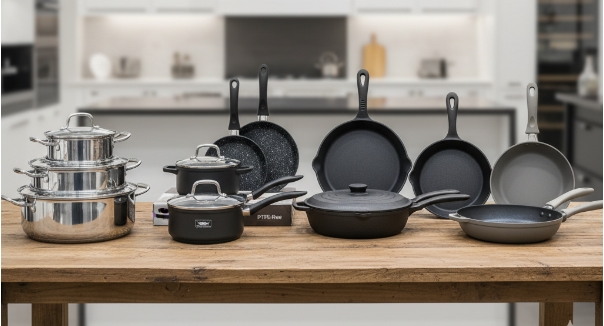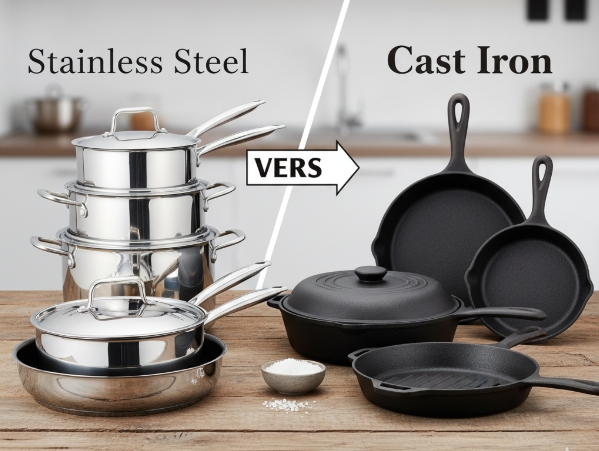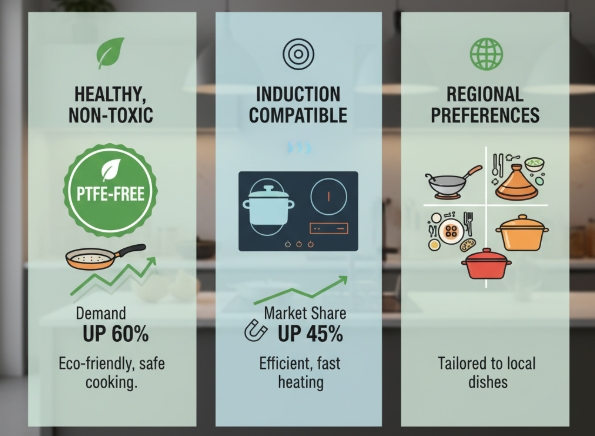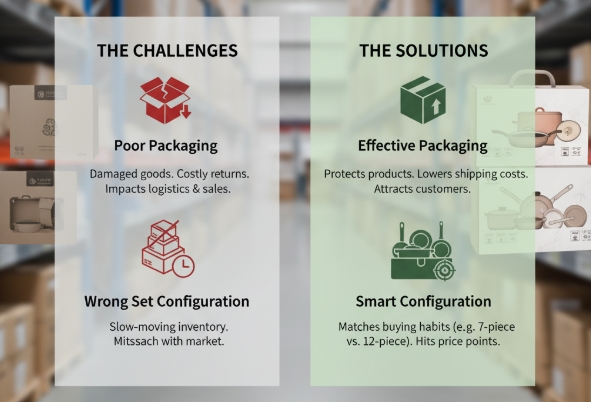Sourcing the right cookware is confusing. The wrong choice leads to unsold stock and lost profits. Let me simplify your decisions with this essential guide for importers and wholesalers.
The most common and profitable cookware sets for overseas kitchenware importers & wholesalers include stainless steel, non-stick (especially PTFE-free), cast iron, and aluminum. These materials cover diverse market needs, from high-end durability and performance to budget-friendly convenience, ensuring you can build a successful and well-rounded product portfolio.

As a manufacturer with over 25 years in the business, I've seen countless trends come and go. But one thing remains constant: success in this industry comes from understanding not just the products, but the people who buy them. It's about matching the right material and design to the right market. A premium stainless steel set that sells out in Europe might gather dust on a shelf in Southeast Asia, where a lightweight non-stick set is preferred. Making smart sourcing decisions is the foundation of a profitable partnership, and that's what I want to help you with today. Let's break down the details so you can source with confidence.
How do different cookware materials impact your product strategy?
Choosing the wrong material can alienate your target customers. You might be stuck with inventory that doesn't match market demand. Understand which materials appeal to which consumer segments for better sales.
Stainless steel and cast iron target premium markets with their durability and performance. Aluminum and ceramic-coated cookware appeal to the mass market with affordability and convenience. Aligning material choice with your target consumer is the key to a successful product strategy.

When we develop a new line, the first question is always about the material. It dictates everything from the price point to the marketing message. Each material serves a distinct purpose and attracts a different kind of buyer. Your role as an importer or wholesaler is to build a portfolio that meets these varied demands. You need to balance high-margin premium products with high-volume, budget-friendly options. Understanding the core attributes of each material is the first step in creating that balance and maximizing your market reach. Below is a breakdown I often share with my partners.
A Deeper Look at Core Materials
Let's compare the most common materials used in cookware sets today. This will help you decide where to invest.
| Material | Key Benefits | Target Market | Price Point | Our Manufacturing Insight |
|---|---|---|---|---|
| Stainless Steel | Durable, non-reactive, professional look, excellent heat retention. | Home chefs, health-conscious consumers, premium market. | Mid to High | Our 3-ply and 5-ply constructions are very popular in European and North American markets for superior heat distribution. |
| Cast Iron | Unmatched heat retention, extremely durable, versatile (stovetop to oven). | Traditional cooks, outdoor enthusiasts, specialty cooking. | Mid to High | While heavy, its longevity is a major selling point. We recommend enameled options for easier maintenance. |
| Aluminum (Non-Stick) | Lightweight, excellent heat conductor, affordable. | Everyday cooks, beginners, mass market. | Low to Mid | The key here is the quality of the non-stick coating. We focus on durable, PFOA-free coatings to meet health standards. |
| Copper | Superior heat conductivity, precise temperature control, beautiful aesthetic. | Gourmet chefs, luxury market, design-focused consumers. | High / Premium | Copper is a niche but profitable market. It requires more maintenance, so the target buyer is usually a dedicated cooking enthusiast. |
What market trends should you focus on when sourcing cookware?
Consumer tastes change quickly, leaving you with outdated products. Staying ahead of trends is crucial. Let's focus on the shifts that directly impact sales and profitability in the cookware market.
Focus on three key trends: the rising demand for healthy, non-toxic coatings (PTFE-free), the growing popularity of induction-compatible cookware, and the need to address specific regional cooking preferences. These trends are shaping consumer buying decisions globally.

We invest heavily in R&D to stay ahead of these trends. It’s not just about making pots and pans; it's about solving problems for the end consumer. For example, the shift toward healthier lifestyles isn't just a fad; it's a fundamental change in how people view their kitchen tools. Likewise, the rise of energy-efficient appliances like induction cooktops means that cookware must adapt. As an importer, your ability to spot these shifts and source products that meet these new demands will set you apart from competitors who are still selling last year's models.
Navigating Global Consumer Demands
Understanding these trends is essential for building a relevant and profitable product catalog. Let’s break down the most impactful ones.
Health and Eco-Consciousness
Consumers, especially in Europe and North America, are more aware of the materials in their kitchens. They are actively searching for products labeled "PFOA-free," "non-toxic," and "eco-friendly." This trend has fueled the rise of ceramic non-stick coatings and a renewed interest in inert materials like stainless steel and glass. For you, this means verifying supplier certifications and prioritizing products with clear health and safety benefits. Marketing these features on your packaging can significantly boost sales.
The Induction Revolution
Induction cooktops are becoming standard in new homes and remodels due to their efficiency and safety. Any cookware that isn't induction-compatible is losing a significant portion of its potential market. We've made induction-ready bases standard on over 90% of our new stainless steel and aluminum lines. When sourcing, always check for the induction symbol and confirm the base is made of a ferromagnetic material. This is no longer a premium feature; it's a market necessity.
Regional Cooking Preferences
A one-size-fits-all approach doesn't work.
- Middle East: Traditional slow-cooking methods mean there's a strong demand for heavy-duty cookware like cast iron casseroles and large stockpots.
- Southeast Asia: Fast-paced cooking styles favor lightweight non-stick woks and frying pans.
- Europe: There's a balance, with a demand for versatile stainless steel sets for classic cuisine and specialized items like crepe pans or paella pans.
Tailoring your product offerings to these cultural nuances can open up new revenue streams and build stronger market penetration.
How can you properly evaluate a cookware supplier?
Partnering with an unreliable supplier can lead to quality issues, shipping delays, and financial loss. It's a risk you can't afford. The key is to look beyond the product price.
A great supplier has verifiable quality control standards like BSCI or ISO certification, a proven track record of on-time delivery, and the flexibility to offer customization. Prioritize clear communication and their ability to be a long-term partner, not just a one-time vendor.
I've built my business on the principle of partnership. When a new client comes to us, I don't just see an order number; I see a long-term relationship. A low price is meaningless if the products arrive late or fail to meet quality standards. We invite our partners to visit our 10,000-square-meter facility, see our advanced machinery, and meet our R&D team. This transparency builds trust. You should demand the same from any potential supplier. A good partner is invested in your success because it ensures their own.
Creating Your Supplier Checklist
Evaluating a potential manufacturing partner requires a structured approach. Here are the key areas I advise my clients to focus on.
Production Capability and Quality Control
Don't just take their word for it. Ask for documentation. A BSCI audit report tells you they adhere to ethical social standards. An ISO 9001 certification confirms they have a robust quality management system in place. Ask about their production capacity. Can they handle your volume during peak season? In our factory, we've invested in advanced machinery not just to increase output, but to ensure consistency from the first piece to the ten-thousandth.
Customization and Flexibility
Your brand is your biggest asset. Can the supplier help you enhance it? Ask about their OEM/ODM capabilities. This includes:
- Custom Logos: Etching or stamping your brand onto the product and lid.
- Handle Options: Offering different materials (stainless steel, silicone, bakelite) and shapes.
- Packaging Design: Working with you to create custom-branded boxes that stand out on the shelf. A supplier who offers this flexibility is a true partner, helping you differentiate your products in a crowded market.
Communication and Relationship Management
This is perhaps the most critical element. Are they responsive? Do they provide clear timelines and updates? Cultural and language barriers can be a challenge, so working with a team that has experience with international clients is a major advantage. A good partner will alert you to potential production delays proactively and work with you to find solutions. This level of service is what turns a simple transaction into a lasting, profitable relationship.
Why is packaging and configuration so important?
Poor packaging can lead to damaged goods and costly returns. The wrong set configuration results in slow-moving inventory. This is a critical final step that many overlook, impacting logistics and sales.
Effective packaging protects the product, minimizes shipping costs, and attracts customers. Smart configuration means creating sets (e.g., 7-piece vs. 12-piece) that match the buying habits and price points of your specific target market.

We learned this lesson years ago. We produced a beautiful 15-piece cookware set, but the box was too large and heavy. Retailers complained about the shelf space, and the shipping costs were eating into our clients' margins. We quickly redesigned the packaging to be more compact and created smaller, more focused set configurations. Sales immediately improved. Packaging isn't just a box; it's part of the product experience and a key factor in logistical efficiency. It needs to be a core part of your product development conversation with any supplier.
Optimizing Your Product Presentation and Logistics
Let's explore how to make strategic decisions about packaging and set composition to improve your bottom line.
The Rise of Eco-Friendly and Custom Packaging
In today's market, packaging is a powerful branding tool.
- Eco-Friendly Materials: Especially in Europe and North America, consumers are choosing brands that use recyclable cardboard and reduced plastics. Sourcing products with sustainable packaging is not only good for the planet but also a strong marketing claim that can justify a higher price point.
- Custom Branding: Your box is your first impression. A generic brown box won't cut it. Work with your supplier to design full-color retail packaging that highlights key features, showcases your brand, and looks great on a shelf or a product listing page. This investment in design pays for itself through increased sales and brand recognition.
Strategic Set Configuration
More is not always better. Offering different set sizes allows you to hit various price points and meet different consumer needs.
- Starter Set (3-5 pieces): Ideal for first-time homebuyers, students, and budget-conscious consumers. Typically includes a small frying pan, a small saucepan, and a larger stockpot.
- Family Set (7-10 pieces): The most popular configuration. It offers a versatile range of sizes for everyday cooking, appealing to the mass market.
- Complete Set (12+ pieces): Targets serious home cooks and the gift market (e.g., weddings). It commands a higher price but has a smaller target audience.
By offering a few well-thought-out configurations, you can cater to a wider audience without having to manage dozens of different SKUs.
Conclusion
Sourcing the right cookware comes down to understanding materials, market trends, supplier quality, and smart packaging. Focusing on these core elements will build a profitable and sustainable product line for your business.